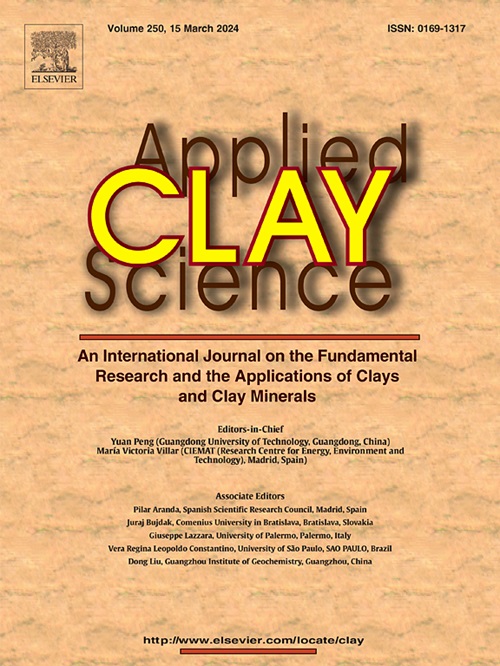高岭土风化层的矿物学和同位素特征:来自尼日利亚中部Ropp杂岩Kuba地区的古气候信息
IF 5.8
2区 地球科学
Q2 CHEMISTRY, PHYSICAL
引用次数: 0
摘要
库巴高岭土风化层为研究黑云母-花岗岩原岩的风化过程及其与古气候条件的关系提供了依据。利用x射线衍射、电感耦合等离子体质谱、x射线荧光、差示扫描量热法和稳定同位素(ẟ18O, ẟ2H)分析了风化层的矿物学和地球化学性质。风化层主要由高岭石和伊利石组成,属于亚近代热带风化体系。高岭石始终存在,表面附近的水分可用性略有增加。同位素值(ẟ18O: +9.2 ~ +16.2‰;ẟ2H:−83 ~−40‰)表明大气和热液流体之间存在相互作用,地层温度为47 ~ 65℃。这些数值超过了典型的地表风化温度,表明存在低温热液蚀变或深部热地下水循环,而非单纯的表生作用。气候转变的证据包括元素淋溶趋势和同位素变化,表明干湿交替循环。从顶部到底部的古温度下降也表明从温暖潮湿的气候到凉爽的气候条件的转变,支持了更广泛的气候演变。元素损失(Na, Ca, K, Mn, Mg)和相对稳定的TiO2和Al2O3表明选择性浸出。球粒陨石正态稀土元素(REE)模式显示出较强的轻稀土元素(LREE)富集,部分剖面呈现负Eu异常和正Ce异常,提示氧化风化和长石蚀变。深度CIA(蚀变化学指数)>90, MIA(蚀变矿物学指数)>;90的高风化指数表明,长期的流体相互作用驱动了强烈的蚀变,而不仅仅是温度的作用。热分析支持高岭石在普遍条件下的稳定性,使其成为风化环境的关键指标。剖面特征反映了一个以晚新生代气候转变为标志的动态气候历史,以及非洲湿润期对风化过程的重要影响。本文章由计算机程序翻译,如有差异,请以英文原文为准。
Mineralogical and isotopic signatures of kaolin regolith: Paleoclimate insights from the Kuba area, Ropp Complex (central Nigeria)
The Kuba kaolin regolith provides insights into weathering processes during soil formation on a biotite-granite protolith and their relationships to paleoclimate conditions. Mineralogical and geochemical properties of the regolith were analyzed using X-ray diffraction, inductively coupled plasma mass spectrometry, X-ray fluorescence, differential scanning calorimetry, and stable isotopes (ẟ18O, ẟ2H). The regolith consists mainly of kaolinite and illite, representing a tropical weathering regime of sub-recent age. Kaolinite persists throughout, with a slight increase in moisture availability near the surface. Isotope values (ẟ18O: +9.2 to +16.2 ‰; ẟ2H: −83 to −40 ‰) suggest an interplay between meteoric and hydrothermal fluids, with formation temperatures ranging from 47 °C to 65 °C. These values exceed typical surface weathering temperatures, indicating low-temperature hydrothermal alteration or deep circulation of heated groundwater, rather than purely supergene processes. Evidence for climate transitions includes elemental leaching trends and isotopic shifts, indicating alternating wet-dry cycles. A paleotemperature decrease from the top to the base of the section also indicates a shift from a warmer, humid climate to cooler conditions supporting a broader climatic evolution. Elemental losses (Na, Ca, K, Mn, Mg) and relatively stable TiO2 and Al2O3 suggest selective leaching. Chondrite-normalized rare earth elements (REE) patterns display strong light rare earth elements (LREE) enrichment, a negative Eu anomaly, and a positive Ce anomaly in some sections, signaling oxidative weathering and feldspar alteration. High weathering indices at depth CIA (chemical index of alteration) >90, MIA (mineralogical index of alteration) >90) suggest intense alteration driven by prolonged fluid interaction rather than temperature alone. Thermal analysis supports kaolinite's stability under the prevailing conditions, making it a key indicator of the weathering environment. The profile's signatures reflect a dynamic climate history marked by Late Cenozoic climatic transitions and significant influences from the African Humid Period on weathering processes.
求助全文
通过发布文献求助,成功后即可免费获取论文全文。
去求助
来源期刊

Applied Clay Science
地学-矿物学
CiteScore
10.30
自引率
10.70%
发文量
289
审稿时长
39 days
期刊介绍:
Applied Clay Science aims to be an international journal attracting high quality scientific papers on clays and clay minerals, including research papers, reviews, and technical notes. The journal covers typical subjects of Fundamental and Applied Clay Science such as:
• Synthesis and purification
• Structural, crystallographic and mineralogical properties of clays and clay minerals
• Thermal properties of clays and clay minerals
• Physico-chemical properties including i) surface and interface properties; ii) thermodynamic properties; iii) mechanical properties
• Interaction with water, with polar and apolar molecules
• Colloidal properties and rheology
• Adsorption, Intercalation, Ionic exchange
• Genesis and deposits of clay minerals
• Geology and geochemistry of clays
• Modification of clays and clay minerals properties by thermal and physical treatments
• Modification by chemical treatments with organic and inorganic molecules(organoclays, pillared clays)
• Modification by biological microorganisms. etc...
 求助内容:
求助内容: 应助结果提醒方式:
应助结果提醒方式:


